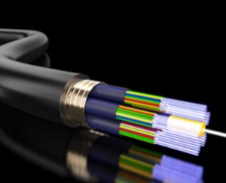
Coating on optical fiber:
Light is directed down the core of the fiber by an optical cladding with a low refractive index that traps the light in the core through total internal reflection. The cladding is coated by a buffer that protects it from moisture and physical damage. The buffer coating is what separates the fibers for termination or splicing. These coatings are UV-cured urethane acrylate composite or polyimide materials that are applied to the outside of the fiber during the drawing process.
The coatings protect the very delicate strands of glass fiber—about the size of a human hair—and allow it to survive the rigors of construction, proof testing, cabling, and installation. Today’s glass optical fiber draw processes use a dual-layer coating approach. An internal primary coating is designed to act as a shock absorber to reduce attenuation caused by microbending. An outer secondary coating protects the primary coating against mechanical damage and acts as a barrier to lateral forces, and maybe colored to separate wires in bundled cable construction. These fiber optic coating layers are applied during fiber draw at speeds of up to 100 kilometers per hour (60 mph). Optical polarizers are used with custom optical beamsplitters by the optical products manufacturer to manufacture products.
Either wet-on-dry or wet-on-wet method is used to apply fiber optic coatings. In wet-on-dry, the fiber undergoes a primary coating application, which is then UV cured—then through a secondary coating application, which is then cured. In wet-on-wet, the fiber undergoes both primary and secondary coating applications, then goes into UV curing. Fiber optic coatings are applied in concentric layers to protect the fiber from damage during drawing application and to maximize fiber strength and microbend resistance. When the coating expands or contracts, the unevenly coated fiber will experience non-uniform forces and is more susceptible to signal attenuation. Under proper drawing and coating procedures, coatings are concentrated around the fibers, are continuous over the length of the application, and have a constant thickness. The thickness of the coating is taken into account when calculating the stress that the fiber will experience under different bend configurations.
Use of Coating
The fiber optic coating protects the glass fiber from scratches that can lead to a drop in strength. The combination of scratches and moisture fasten up the process of aging and deterioration of fiber strength. When a fiber is subjected to low stress over a long period of time, fiber fatigue can occur.
